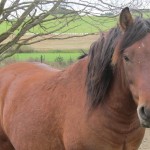WILD HORSES RETURN TO THE HEART OF EUROPE – THANKS TO THE EXMOOR PONY
WILD HORSES RETURN TO THE HEART OF EUROPE – THANKS TO THE EXMOOR PONY
By Sona Meikle
Wild horses are getting ready for a comeback toCentral Europe. Their return is a key part of a programme by European Wildlife, which aims to restore natural pastures, flowering meadows and other elements of biodiversity.
“In the past centuries wild horses were exterminated. But their genes have survived in some primitive breeds of horses,” says Dalibor Dostal, director of European Wildlife.
According to experts, by back-breeding animals in which genes of wild horses have been preserved, it is possible to get horses which will correspond to the original wild horses, resemble their appearance, size, colour, behaviour and even their undemanding nature when it comes to dietary diversity.
The project will work with two primitive horse breeds which are close to the original wild horses. One of them is the Hucul, a breed that originally comes from the Carpathian Mountains and is very close to the original wild horses that used to inhabit the region. The other one is the Exmoor pony which comes from the British Isles and seems not to have changed much since the Ice Age.
In this project European Wildlife is cooperating with two partners; Czech breeders of Hucul horses and the Taurus Foundation from the Netherlands which has long-term experience with breeding of Exmoor ponies.

In the first few years the animals will be kept in vast enclosures. Then only those individuals which most resemble the characteristic of wild horses will be selected for further breeding. The long-term aim is to create horses which will resemble herds that used to inhabit Europe.
The attempt to back-breed wild horses had already taken place in 1930s Poland. The outcome was the Konik. However, new scientific findings, including DNA analyses, show that, in many ways, Konik does not resemble original wild horses.
“From genetic researches, we have learned that theExmoorpony is the closest relative we have to the Northwest European prehistoric horse. This is confirmed by other research including bone measurements, historical documents, blood type, coat colour genetics and dental studies,“ explains Henri Kerkdijk from the Taurus Foundation.
Another important aspect is that contrary to the Aurochs, wild horses in Europe seem to have been more diverse in terms of appearance. Horses in general are more adaptable to changing circumstances and the diverse climates, landscapes and vegetation in Europe have resulted in different Horse ecotypes suited to local circumstances.
The Hucul horses bred in the Czech Republic have many genes of the original wild horse, but in an attempt to save local Hucul horses, they have been cross-bred with several other horse breeds in the past decades, for example Hafling or Fjord. That is why for back-breeding only those individuals that most resemble the original wild horses of the region will be selected.
There is yet another aim of European Wildlife´s project; in cooperation with experts they will observe how both breeds – Huculs and Exmoor ponies – can adapt in Central Europe with its specific climate, terrain and vegetation.
Central Europe is situated between the areas of occurrence of both horse breeds. For instance, the distance between the heartland of the Hucul, Romania, and Prague is about 1070 km and the distance between the heartland of the Exmoor pony and Prague is about 1250 km. That is why adaptability of both types of horses is going to play a key role in deciding which breed will be chosen to work with in the framework of the project dedicated to the return of wild horses to Central Europe.
About European Wildlife:
European Wildlife is a non-profit organisation dedicated to nature conservation and landscape protection. Its key objective is to conserve biological diversity and to reduce the impact of climatic changes on nature and humankind.
